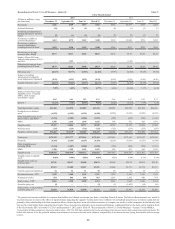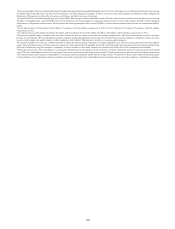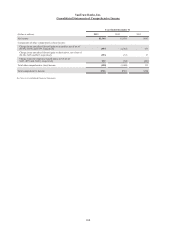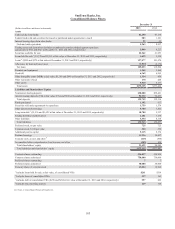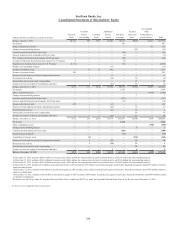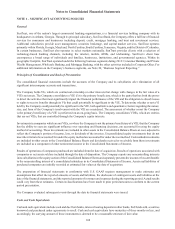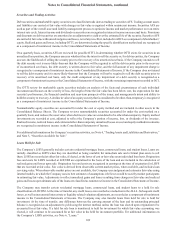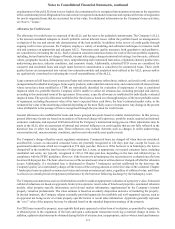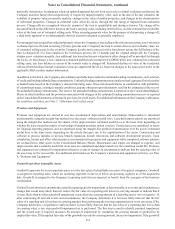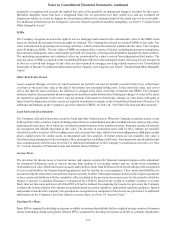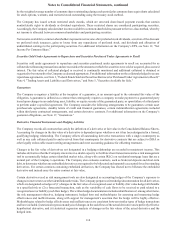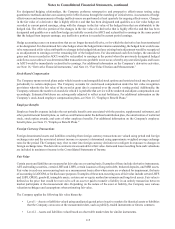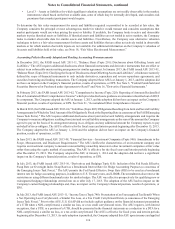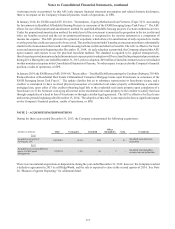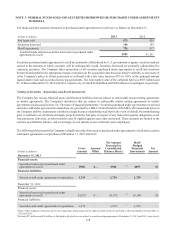SunTrust 2013 Annual Report Download - page 125
Download and view the complete annual report
Please find page 125 of the 2013 SunTrust annual report below. You can navigate through the pages in the report by either clicking on the pages listed below, or by using the keyword search tool below to find specific information within the annual report.Notes to Consolidated Financial Statements, continued
109
Securities and Trading Activities
Debt securities and marketable equity securities are classified at trade date as trading or securities AFS. Trading account assets
and liabilities are carried at fair value with changes in fair value recognized within noninterest income. Securities AFS are
used as part of the overall asset and liability management process to optimize income and market performance over an entire
interest rate cycle. Interest income and dividends on securities are recognized in interest income on an accrual basis. Premiums
and discounts on debt securities are amortized as an adjustment to yield over the estimated life of the security. Securities AFS
are carried at fair value with unrealized gains and losses, net of any tax effect, included in AOCI as a component of shareholders’
equity. Realized gains and losses, including OTTI, are determined using the specific identification method and are recognized
as a component of noninterest income in the Consolidated Statements of Income.
On a quarterly basis, securities AFS are reviewed for possible OTTI. In determining whether OTTI exists for securities in an
unrealized loss position, the Company assesses whether it has the intent to sell the security or, for debt securities, the Company
assesses the likelihood of selling the security prior to the recovery of its amortized cost basis. If the Company intends to sell
the debt security or it is more-likely-than-not that the Company will be required to sell the debt security prior to the recovery
of its amortized cost basis, the debt security is written down to fair value, and the full amount of any impairment charge is
recognized as a component of noninterest income in the Consolidated Statements of Income. If the Company does not intend
to sell the debt security and it is more-likely-than-not that the Company will not be required to sell the debt security prior to
recovery of its amortized cost basis, only the credit component of any impairment of a debt security is recognized as a
component of noninterest income in the Consolidated Statements of Income, with the remaining impairment recorded in OCI.
The OTTI review for marketable equity securities includes an analysis of the facts and circumstances of each individual
investment and focuses on the severity of loss, the length of time the fair value has been below cost, the expectation for that
security's performance, the financial condition and near-term prospects of the issuer, and management's intent and ability to
hold the security to recovery. A decline in value of an equity security that is considered to be other-than-temporary is recognized
as a component of noninterest income in the Consolidated Statements of Income.
Nonmarketable equity securities are accounted for under the cost or equity method and are included in other assets in the
Consolidated Balance Sheets. The Company reviews nonmarketable securities accounted for under the cost method on a
quarterly basis, and reduces the asset value when declines in value are considered to be other-than-temporary. Equity method
investments are recorded at cost, adjusted to reflect the Company’s portion of income, loss, or dividends of the investee.
Realized income, realized losses, and estimated other-than-temporary unrealized losses on cost and equity method investments
are recognized in noninterest income in the Consolidated Statements of Income.
For additional information on the Company’s securities activities, see Note 4, “Trading Assets and Liabilities and Derivatives,”
and Note 5, “Securities Available for Sale.”
Loans Held for Sale
The Company’s LHFS generally includes certain residential mortgage loans, commercial loans, and student loans. Loans are
initially classified as LHFS when they are identified as being available for immediate sale and a formal plan exists to sell
them. LHFS are recorded at either fair value, if elected, or the lower of cost or fair value on an individual loan basis. Origination
fees and costs for LHFS recorded at LOCOM are capitalized in the basis of the loan and are included in the calculation of
realized gains and losses upon sale. Origination fees and costs are recognized in earnings at the time of origination for LHFS
that are recorded at fair value. Fair value is derived from observable current market prices, when available, and includes loan
servicing value. When observable market prices are not available, the Company uses judgment and estimates fair value using
internal models, in which the Company uses its best estimates of assumptions it believes would be used by market participants
in estimating fair value. Adjustments to reflect unrealized gains and losses resulting from changes in fair value and realized
gains and losses upon ultimate sale of the loans are classified as noninterest income in the Consolidated Statements of Income.
The Company may transfer certain residential mortgage loans, commercial loans, and student loans to a held for sale
classification at LOCOM. At the time of transfer, any credit losses are recorded as a reduction in the ALLL. Subsequent credit
losses, as well as incremental interest rate or liquidity related valuation adjustments, are recorded as a component of noninterest
income in the Consolidated Statements of Income. The Company may also transfer loans from held for sale to held for
investment. At the time of transfer, any difference between the carrying amount of the loan and its outstanding principal
balance is recognized as an adjustment to yield using the interest method, unless the loan was elected upon origination to be
accounted for at fair value. If a held for sale loan is transferred to held for investment for which fair value accounting was
elected, it will continue to be accounted for at fair value in the held for investment portfolio. For additional information on
the Company’s LHFS activities, see Note 6, “Loans.”


